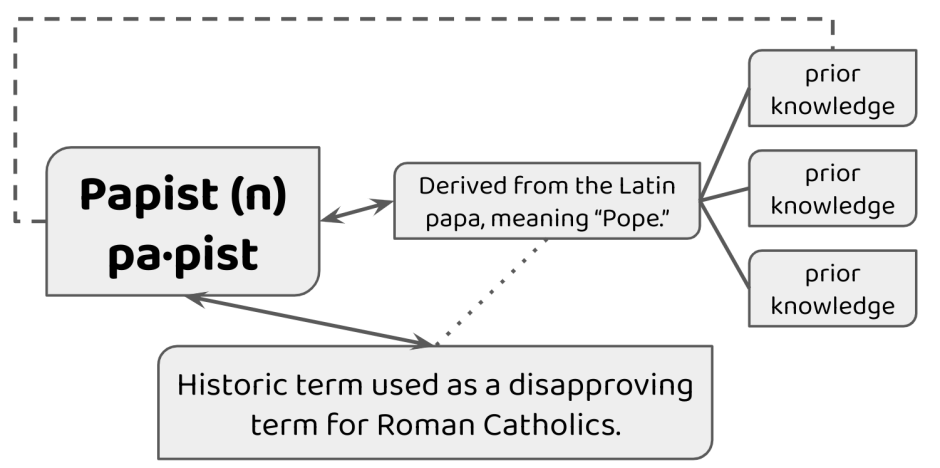We have already covered a lot of ground. So to gain a firmer footing… and ‘walking-the-walk,’ in promoting a ‘successive relearning’ approach to teaching, here goes with a review of Part I with a smattering of testing. Little is ever new in education.
Reactivation of prior learning with a little testing
If attention is the bottleneck of learning. Prior knowledge informs perception, and perception directs attention – we need to consider prior knowledge the primer influencer of potent and durable learning. We need to ascertain pupils/classes prior knowledge before teaching. If positioning memory as ‘recon _ _ _ _ _ _ _ _ _* rather than objective’ and therefore learning ‘a pro _ _ _ _* and not an event,’ as teachers we are also required to think deeply about the curriculum we prioritise, the weight and sequence of that curriculum, and the curriculum we decide not to include. We would be well advised to provide opportunities to teach information with awareness of the limitations of working memory, for pupils to encode/learn information, and reteach knowledge for pupils to remember/relearn/maintain knowledge and exploit our understanding of spacing effects.
reconstructed* and process*
And finally, to illustrate why this is important and with the end in mind (that is – you understanding that information and knowledge are distinctly different and should therefore be taught distinctly differently) I am going to undertake two education experiments, or edperiments, based on a real-life experience. These edperiments we aim to move to very different sets of “items” to long-term memory.
Edperiment 1: Information to encode/learn (unfamiliar or new information)
Edperiment 2: Knowledge to remember/relearn/maintain (familiar knowledge, not recently accessed)
The aim here is for you to experience the memorial differences of encoding/learning when compared to remembering/relearning/maintaining and in doing so, reaffirming why “retrieved and stored semi-permanent” is misleading and (modified and) maintained and reconstructed is more useful. Second, encourage you to adopt distinctly different teaching approaches dependent of the ‘state’ of the item: information or knowledge.
Caveates: I have no way to assess your prior knowledge (the prime influencer in learning) or ways to check for your understanding. The only background contextual information I have is, you are reading this blog, this post, and that you hopefully read ‘On my terms (Part I)‘ and therefore likely involved in education.
Edperiments 1a and 1b: Information to encode/learn (50:50 known to the reader)
As teachers, we plan for, or encounter new vocabulary with our pupils all the time, some teachers encounter more new vocabulary than others. I have selected two uncommon modern English words, “not frequently used in polite conversation.” Selected as information. According to my research, the first word is more familiar than the second word. Both are relatively easy to read and pronounce, with no silent letters. Both are lifted from the same sentence from my youngest son’s reading book (categorised for readers 9+). I’m holding back the title of the book for a moment – as this may activate prior knowledge and send neuro sparks flying.
Methodology
You will be presented with a diagnostic cue, the item/word and expected to return the target cue, the meaning of that word. Hints are available. I would suggest that word-definition diagnosticity is relatively high. Think flashcards.
| Diagnostic cue (Uncommon word) | Target cue (definition) | Hint or note |
|---|---|---|
| king (n) | A male ruler of an country usually by right of birth. | Monarch |
As I said in Part I – it is rare to find completely disconnected or discrete information, hence research prefers to use foreign language word-pairs to control for prior knowledge in research experiments. In case you were wondering which language, Swahili is often used for a number of linguistic reasons explained by Dr Wiseheart in her excellent presentation ‘Using spacing to boost retention.‘ Using Swahili felt a little too abstract, too distant from most classrooms, hence I went with uncommon modern English words. Second, as I had experienced these very examples, witnessed my son’s reaction to them and pride in learning and using them, I thought they were good candidates. The potential drawback is that there is a chance that one or both words will be known to you (and therefore not information but rather knowledge) and according to a short Twitter poll back in January 53% of respondents knew both words and that put me to shame. Back to Edperiment 1.
Participants
Consider yourself invested. This task holds high value for you as a learner. Your teacher is word curious and you are too.
Remember these two information items were lifted from a book categorised for readers 9+. That I am planning edperiment 1 with the forethought you are most likely a graduate teacher. I do not know your prior vocabulary knowledge. You will be presented with a single word (or diagnostic cue) as it would be designed for RememberMore (cue (word class) syllabification) and asked to say / ‘produce’ the meaning of that word.
Experiment 1a: Information to encode/learn
papist (n) pa·pist
After decoding the word, you will have then sought to retrieve it’s meaning from your semi-permanently stored knowledge in long term memory.
If the target cue is accessible, you will have retrieved it by now. Moreover, you will have retrieved-encoded it, (modified and) maintained and reconstructed ‘papist’ with any knowledge acquired since you last encountered the word and that schema. You may also now associate ‘papist’ with this test-enhanced learning series. You may well be feeling pretty good about yourself – and rightly so. Using your memory has shaped your memory (and motivation).
If the target cue was known yet inaccessible, rest assured that your retrieval effort (remember you are invested and thinking hard)is not wasted in the long-term. You are experiencing lethologica or the tip-of-the-tongue phenomenon, the temporary inability to retrieve information from the not-so-reliable stored in semi-permanent long-term memory. You will be feeling _________________ – depending on your motives and how you value the task.
Both confirmatory feedback (follow successful retrieval) and corrective feedback (the presentation of the definition) aid relearning or remembering/relearning. You will be comparing your answer with the teachers preferred meaning. There are, of course, degrees of correctness. In both cases the knowledge is now ‘more’ than it was, is has been (modified and) maintained and reconstructed.
If incorrect, corrective feedback, if designed expertly, should aid an initial encoding/learning of the target cue.
If indeed the item/word is ‘new’ to you as I half expected (and a weak Twitter poll predicted), as it was for me, you will now be anticipating the target cue, the word meaning. Which is in this methodology, corrective feedback. You will be feeling __________________ – depending on your motives and how you value the task. In truth, even with the context of the book, the scene, I was not sure I knew what ‘papist’ meant.
Before presenting the target cue, may I first offer a hint. A useful strategy in most learning settings, in class, as homework, with questions and in quizzes generally.
HINT: “Papist” is derived from the Latin papa, meaning “Pope.”
Here the hint is refining or narrowing the possible target cues / answers and/or amplifying the diagnostic cue, prompting association of papist/pope and various other connections that the hints elicits based on your prior knowledge. Hints encourage even more retrieval-encoding. More thinking hard.
Incorrect / unknown diagnostic cues or items/words is information that needs to be encoded, meaning constructed, repeatedly retrieved, connected, practiced, rehearsed, organised or synthesised. Information with low storage and retrieval strength remains vulnerable to forgetting. In my professional experience, easily forgotten by the end of the task, within a lesson, even more likely to be forgotten between subsequent lessons.
| Diagnostic cue (Uncommon word) | Target cue (definition) | Hint or note |
|---|---|---|
| papist (n) pa·pist | Historically used as a | Derived from the Latin papa, meaning “Pope.” |
pejorative* Word strikethrough show words replaced in favour of more familiar words for learning (as might be used when teaching a class, otherwise you would need to teach the meaning of “pejorative” also, ad infinitum.)
Let’s review all four outcomes of the word-definition pair for new information.
| Successful retrieval | Unsuccessful retrieval (lethologica) | Incorrect retrieval | Unknown |
|---|---|---|---|
| Diagnostic cue signals the target cue | Target cue is inaccessible | Diagnostic cue fails to signal the target cue | Unknown diagnostic cue |
| Confirmatory feedback | Confirmatory feedback | Corrective feedback overrides incorrect information and encodes correct information | Corrective feedback supports the encoding of information |
| Remembering adds storage strength and retrieval strength | Relearning adds storage strength and temporarily boosts retrieval strength | Encoding has low storage strength and retrieval strength | Encoding has low storage strength and retrieval strength |
| Elaboration would be a suitable teaching strategy | Encourage ‘production’ of both diagnostic and target cues | Repeated retrieval in the lesson | Encourage an answer Repeated retrieval in the lesson |
| Extend spacing or weight/breadth of content sampled | Short Spacing | Homework / repeated retrieval next lesson | Homework / repeated retrieval next lesson |

Again, what is prior knowledge? As you can see, coding items as either information or knowledge is professionally challenging. This is undoubtedly important to discern and yet incredibly difficult to do so for relatively simple items such as a word. Second, coding / teaching just a single word, to a single learner, presents four possible outcomes, transfer that to a cluster of words, to a class of thirty.
Even this narrow dissection of teaching reveals it’s complexity.
So rather than takeaways, let’s reflect for a moment before moving forward with edperiment 1b.
Reflections
- How did you interact with the diagnostic cue?
- How would you describe the diagnosticity of that diagnostic cue for the target cue?
- If you knew the meaning of the ‘papist’ – how accurate or matching was your definition?
- If you didn’t know the meaning of the ‘papist’ – did the hint help? Do you know the meaning of ‘papist’ now? Will you remember it tomorrow?
- How did you feel about the hint?
- What are your thoughts on the distinction of information and knowledge?
- With your newly acquired knowledge, is there anything about this post that you now see differently?*
Remember, prior knowledge informs perception, and in turn perception directs attention. Take a look at the post again? Did you notice anything about the featured image?



Pingback: Test-enhanced learning: On my terms (Part I) – Edventures
Pingback: Test-enhanced learning: knowledge is not information (part III) – Edventures
Pingback: Test-enhanced learning: Successive Relearning (part IV) – Edventures